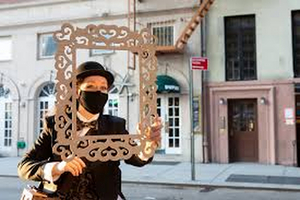Review: An intoxicating VOYEUR: THE WINDOWS OF TOULOUSE-LATREC by Bated Breath Theatre Company
Visiting 1899's Paris by walking through Greenwich Village

An audience of eight checks in outside The Duplex in Greenwich Village. On a gorgeous Friday evening, there were people all around drinking outside bars at tables and dancing to disco tunes in Christopher Park. Waiting for the show to begin, turn in any direction and there are visuals and sounds setting the mood. Voyeur: The Windows of Toulouse-Latrec conjures up Paris circa 1899 in the bohemian nightclub vista of Montmartre.
For those unfamiliar with the story of Toulouse-Latrec, there are four posters which provide a brief overview of his remarkable and difficult life. He was born into an aristocratic family. His parents were first cousins. It is assumed that fact, and a family history of inbreeding, led to his congenital bone disorders and stunted growth. Unable to play sports, he turned to art and made the debauched world of Moulin Rouge explode in his art and posters.
When the pandemic hit, the Bated Breath Theatre Company had just passed the one hundredth performance of its site specific hit, Unmaking Toulouse-Latrec. I found that show diverting but I was mixed regarding its ability to sustain my attention for one hour. With no theaters now open, Mara Lieberman conceived and directed Voyeur. The artist and story is the same. This experience is fantastically surreal and, at the same time, quietly reflective.
Above the bar Kettle of Fish (opened in 1950), three prostitutes begin their dance in the windows. Windows and picture frames will recur as we voyeuristically peer into the past. The show is scored with a crank music box and a violin. Eight of us are listening to the words being spoken but everyone on the street is watching the action. One of the patrons that evening had previously seen the show taking place and decided to purchase a ticket. Cell phones everywhere were capturing just another provocative night in bohemia. While the technology suggested modern times, the environment brilliantly overwhelmed the senses and set the mood.
Henri is portrayed with a puppet memorably designed by James Ortiz (The Woodsman). His size is diminutive and his pained face is haunting. Both parents are played by actor/dancers. You will see them playfully frolic during their youth and also experience the later darker days, including father Alphonse's tormented anguish after Henri's death. All of this happens walking around the streets of the Village.
Occasionally the group stops to peer into a store front. In one such instance, we watch Henri as the voyeur. The scene displays a sensual provocation that perfectly illuminates this particular moment in time. Another scene at the Ruth E. Wittenberg Triangle was a spectacle of light, movement and silent storytelling. All with cars and people in motion, some stopping to watch as well. What makes Voyeur so fascinating - and even a little uncomfortable - is the continually shifting perspectives of who is the voyeur and who is the "voyee."
Known for his Moulin Rouge posters and paintings of dancers and prostitutes, one of his subjects comes to life during the performance. The Can-Can is invoked. The Moulin Rouge was created so the wealthy could slum it up in a fashionable district. In another thematic twist, this audience does the same. Theatergoers paying for a peek. Amidst this hedonistic environment, an alcoholic cripple with syphilis found his people and became a legendary artist.
The ending of Voyeur: The Windows of Toulouse-Latrec is as memorable as the beginning but in many different ways. Walking to our restaurant reservation after the performance, two of us kept discussing our favorite segments. That probably says it all. This show is not only immersive, it is intoxicating.
Voyeur: The Windows of Toulouse-Latrec is running on certain days through November 7th with multiple performances per evening. The show is a pandemic friendly theatrical experience with masks and limited group sizes, including one visit indoors.
Reader Reviews
Videos

